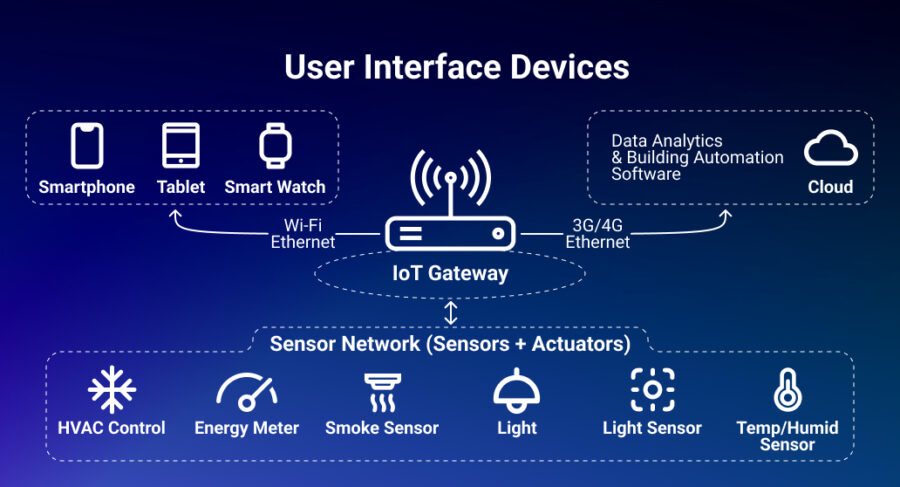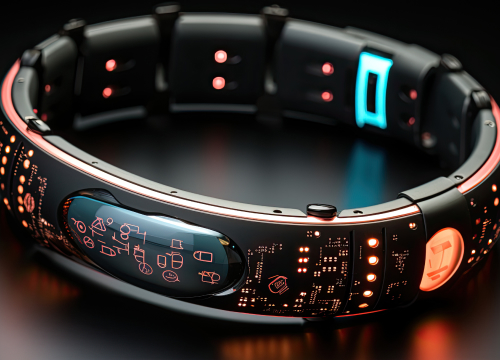
IoT in HVAC Systems: Applications & How Does It Work?

Smart buildings and homes were developed to make peoples’ lives more convenient and comfortable. Thanks to HVAC systems, smart homeowners can now forget about the inconvenience and lack of comfort because of too high or too cold temperatures in the living or working area.
But how exactly does HVAC technology work, and what are the benefits of implementing it in your home or office? How IoT affects HVAC? How IoT makes HVAC smart?
Role of the Internet of Things in HVAC
In buildings, HVAC systems play an extremely significant role in providing air conditioning during summers and heating during winters. The Internet of Things has greatly enhanced HVAC technology, making it more accessible and convenient for people. As a result, IoT-based HVAC solutions are becoming an integral part of the smart home and smart building industry.
Using IoT solution options in HVAC, the systems can perform a wide range of functions. Therefore, with IoT technology, the performance of HVAC systems can be easily monitored in real-time and adjusted according to the owner’s preferences. For instance, people require HVAC systems to be energy-saving. Users can configure them, so the solutions automatically adjust their output based on occupancy patterns or changes in weather conditions. As a result, this leads to a more energy-efficient system that can reduce energy consumption. It would be challenging to maintain a steady temperature in all rooms without IoT in HVAC.

IoT Applications in HVAC
Remote Monitoring
We have already discussed monitoring, but now we will provide more detailed information about one of the most crucial IoT application options in HVAC. Internet of Things in HVAC systems enables the monitoring of system operation by using IoT-enabled sensors. These sensors can monitor various factors in real-time, including temperature, humidity, air quality, and energy usage. Therefore, the data can be analyzed and given the monitoring results. You will be able to get more accurate predictions and proactive maintenance.
Equipment Monitoring
The most significant benefit of monitoring is that it can address issues before they become actual problems and cause damage. For example, IoT sensors can detect when a piece of equipment is operating outside its normal parameters, indicating that it may be about to fail. This early warning allows preventative maintenance to be performed before the equipment breaks down, reducing downtime and repair costs.
IoT-enabled monitoring systems can also provide valuable insights into overall system performance. By analyzing data on temperature, humidity, and air quality, facility managers can identify areas where the HVAC system may be underperforming and take steps to improve performance, leading to improved occupant comfort and overall system efficiency.
Remote Management
IoT solution for HVAC makes it possible to manage HVAC systems remotely, which can assist in saving time since there is no need to adjust each system manually. Therefore, with IoT-enabled control systems, you can remotely change temperature and airflow settings, ensuring optimal comfort for building residents while minimizing energy waste. This is particularly useful for extensive facilities with multiple HVAC systems, as staff can manage HVAC systems from one location.
Synchronization of Devices
When discussing IoT applications in HVAC, it’s essential to talk about how the synchronization of multiple devices can enhance a smart home. A smart home offers unparalleled convenience and comfort, allowing you to synchronize your HVAC devices with other smart home devices. With voice assistants like Alexa, you can effortlessly control various devices in your home with simple commands. For instance, you can say “Good morning,” and your lights will turn on, your coffee will start brewing, and the temperature in your living room or kitchen will be adjusted to match your morning routine.
Moreover, smart HVAC systems can be programmed to work in sync with other smart devices, such as fans and shutters, enabling you to save energy while maintaining optimal indoor conditions. With this level of automation and integration, you can enjoy a seamless and hassle-free living experience in your smart home.
How Does an IoT-based Smart HVAC System Work?
For a smart HVAC system to effectively carry out commands and make optimal decisions to maintain ideal indoor conditions, it requires a range of sensors, algorithms, and processing capabilities. An algorithm is a set of instructions that enables the smart device to perform specific actions. Like the human brain, the algorithm operates in real-time, considering all the data collected from various sensors.
One commonly used feature among smart home devices is geo-fencing. The technology allows the device to identify the user’s location and activate or deactivate the air conditioning or heating system based on whether the user is at home or in the office. This information is relayed from the user’s smartphone to the cloud and the smart device, allowing for seamless control of the HVAC system.
To implement geo-fencing in a smart HVAC system, the system must be equipped with sensors to detect the user’s location. This can be done through various means, including GPS, Wi-Fi, Bluetooth, or cellular triangulation. The system must also be able to communicate with the user’s smartphone or another mobile device, as this is typically how the user’s location is transmitted to the HVAC system. As a result, once the user’s location is detected and transmitted to the HVAC system, the system can adjust the temperature and other settings based on predefined rules or algorithms. For example, suppose the user is within the virtual boundary, and the outside temperature is above a certain threshold. In that case, the system can automatically turn on the air conditioning to maintain a comfortable temperature inside the space.

Benefits of IoT in HVAC
You might still be wondering how IoT is transforming HVAC and what benefits IoT has for HVAC. IoT-based smart HVAC systems offer numerous benefits that can help people improve their living conditions. These benefits include enhancing energy efficiency, reducing operating costs, and improving indoor comfort and air quality. By leveraging the power of IoT technology, these systems can also help buildings become more sustainable and environmentally friendly while providing a better experience for residents.
There is one benefit that stands out among the others, and that is optimizing energy usage. By analyzing data on energy usage and environmental factors, IoT in HVAC can make adjustments to minimize energy waste and reduce costs. Consider having an unoccupied room that doesn’t require the same temperature as the other rooms in a building. IoT sensors can detect it and adjust the HVAC system accordingly to reduce energy consumption.
Discover Our Unmatched Expertise
What kind of Smart Home with HVAC Systems would be complete without wireless technologies? That’s why Sirin Software specializes in various industries and has developed numerous solutions in wireless technology. One notable example of our expertise is a web app for a wireless technology provider case. Our client had a specific requirement for developing a web page enabling real-time energy distribution management within the surrounding environment. This necessitated the creation of interactive web software with meticulously crafted object models and features.
Consequently, we designed the ultimate solution by building a web application capable of rendering 3D models based on adjustable parameters. To achieve this, we employed ReactJS to outline the web interface, Three.JS to generate 3D models of signal transmission devices, and AWS Cognito to implement a user authentication and control system.
Consider Sirin Software Your Trusted Partner
If you are a product development company that designs IoT-connected HVAC systems, or requires upgrading HVAC products to make them more sophisticated, seeking professional assistance is essential since the technology is highly complex. It demands a profound understanding of hardware, software, and networking. Additionally, an experienced IoT service provider can design and implement a tailored solution that meets the particular requirements of a building.
We can guarantee that with Sirin Software’s services, you can be sure that your device is developed to the highest standard, with keen attention to detail and a focus on efficiency and functionality. This results in devices that are not only reliable and user-friendly but also innovative and cutting-edge, providing a competitive edge in the market. We’re here to help, tell us about your project!
FAQ
What problems does IoT solve in HVAC?
One of the main issues that IoT solves in HVAC is the optimization of energy usage. IoT-enabled HVAC systems can gather real-time data on temperature, humidity, and occupancy, and use this information to adjust the HVAC settings automatically. This results in significant energy savings and reduces the environmental impact of HVAC systems. Another issue that IoT solves in HVAC is maintenance. IoT devices can detect and diagnose issues in HVAC systems, alerting potential issues before they escalate into costly repairs.
Reasons to implement IoT in the HVAC system?
There are several reasons why implementing IoT in the HVAC industry can be beneficial. One of the main advantages is improved energy efficiency. By leveraging IoT sensors and data analytics, HVAC systems can automatically adjust their operations based on real-time environmental conditions, occupancy levels, and weather forecasts. Another benefit of IoT-enabled HVAC systems is enhanced comfort and productivity. With smart thermostats and occupancy sensors, building occupants can customize their comfort settings and enjoy optimal temperatures throughout the day.
Overall, implementing IoT in HVAC systems can result in improved energy efficiency, enhanced comfort and productivity, and more efficient maintenance and operations.
What is HVAC?
HVAC stands for Heating, Ventilation, and Air Conditioning. It refers to the technology used to regulate indoor environmental comfort and maintain acceptable air quality in residential and commercial buildings. The HVAC system controls the temperature, humidity, and air circulation within a building to ensure that occupants are comfortable and healthy.
Why do you need HVAC?
The heating component of the HVAC system is responsible for keeping the indoor space warm during colder months. The ventilation component of the HVAC system is responsible for circulating fresh air throughout the building while removing stale air and pollutants. This is typically achieved through the use of air ducts and air filters. Moreover, the air conditioning component of the HVAC system is responsible for cooling the indoor space during warmer months. This is often achieved through the use of air conditioning units, evaporative coolers, or heat pumps.



